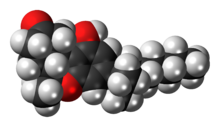User:Mr. Ibrahem/Nabilone
 | |
 Top: (R,R)-(−)-nabilone, Center: (S,S)-(+)-nabilone, Bottom: Space-filling model of (R,R)-(−)-nabilone | |
| Clinical data | |
|---|---|
| Trade names | Cesamet, Canemes |
| AHFS/Drugs.com | Monograph |
| MedlinePlus | a607048 |
| Routes of administration | By mouth (capsules) |
| Drug class | Synthetic cannabinoid[1] |
| Legal status | |
| Legal status |
|
| Pharmacokinetic data | |
| Bioavailability | 20% after first-pass by the liver |
| Protein binding | similar to THC (±97%) |
| Elimination half-life | 2 hours, with metabolites around 35 hours |
| Identifiers | |
| |
| Chemical and physical data | |
| Formula | C24H36O3 |
| Molar mass | 372.549 g·mol−1 |
| 3D model (JSmol) | |
| |
| |
| (verify) | |
Nabilone, sold under the brand name Cesamet among others, is a medication used for chemotherapy-induced nausea and vomiting.[1] Some evidence supports modest effectiveness for fibromyalgia and multiple sclerosis.[3][4] It is taken by mouth.[2]
Common side effects include sleepiness, dry mouth, dizziness, feeling high, poor coordination, and headache.[1] Other side effects may include fast heart rate, abuse, and psychosis.[1] Safety in pregnancy is unclear.[1] It is a synthetic cannabinoid which effects similar to tetrahydrocannabinol (THC), the primary psychoactive compound found in Cannabis.[1][5]
Nabilone was approved for medical use in the United States in 1985.[1] In the United Kingdom 20 pills of 1 mg costs the NHS about £200 as of 2021.[2] This amount in the United States costs about 820 USD.[6] In the United States it is a schedule II controlled substance.[1]
References[edit]
- ^ a b c d e f g h i j "Nabilone Monograph for Professionals". Drugs.com. Archived from the original on 19 October 2020. Retrieved 11 November 2021.
- ^ a b c BNF 81: March-September 2021. BMJ Group and the Pharmaceutical Press. 2021. p. 451. ISBN 978-0857114105.
- ^ Fine PG, Rosenfeld MJ (2013). "The endocannabinoid system, cannabinoids, and pain". Rambam Maimonides Medical Journal (Review). 4 (4): e0022. doi:10.5041/RMMJ.10129. PMC 3820295. PMID 24228165.
- ^ Nielsen S, Germanos R, Weier M, Pollard J, Degenhardt L, Hall W, Buckley N, Farrell M (February 2018). "The Use of Cannabis and Cannabinoids in Treating Symptoms of Multiple Sclerosis: a Systematic Review of Reviews". Current Neurology and Neuroscience Reports. 18 (2): 8. doi:10.1007/s11910-018-0814-x. hdl:2123/18910. PMID 29442178. S2CID 3375801.
- ^ "DailyMed - CESAMET- nabilone capsule". dailymed.nlm.nih.gov. Archived from the original on 25 March 2021. Retrieved 11 November 2021.
- ^ "Cesamet Prices, Coupons & Patient Assistance Programs". Drugs.com. Archived from the original on 9 April 2021. Retrieved 11 November 2021.
